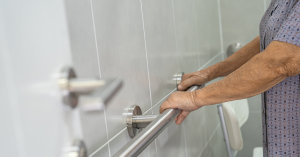
Creating a safe and accessible environment for individuals with disabilities is not just about compliance, it’s about compassion and practicality. Handicap grab bars are a critical component in this endeavour. In Philadelphia, where the architecture ranges from brand-new buildings to centuries-old homes, the installation of these bars must be done with care and precision. Here’s a guide to ensure that handicap grab bars in Philadelphia are placed correctly and installed properly.
Understanding the Importance of Proper Placement of Grab Bars
The correct placement of handicap grab bars is essential for safety and accessibility. These bars provide support and stability for individuals with disabilities or those who are elderly, helping to prevent falls in critical areas such as bathrooms, hallways, and other parts of a home or public facility. In Philadelphia, where the weather can be unpredictable, and stairs are a common architectural feature, these grab bars can be life-saving.
When installing handicap grab bars in a bathroom, correct placement is crucial for safety and ease of use. For the shower or bathtub, bars should be mounted horizontally 33-36 inches above the floor on the back and control walls. Near the toilet, install a bar on the adjacent wall 33-36 inches from the floor, extending at least 42 inches long. Grab bars should be secured to studs or use proper anchors to support weight effectively. Placement should align with the user’s needs, ensuring accessibility and reducing the risk of slips and falls. Proper installation enhances bathroom safety significantly.
Installing grab bars in the bathroom is essential for enhancing safety and accessibility, particularly for individuals with limited mobility and seniors. These grab bars provide support and balance, helping prevent slips and falls in high-risk areas like showers, bathtubs, and near toilets. Grab bars are easy to install and can be placed strategically to offer maximum support, making everyday tasks safer and more manageable. They not only promote independence but also provide peace of mind for caregivers and family members, ensuring the bathroom is a safer environment for everyone.
The Installation Process
Before we dive into the specifics of the grab bar installation process, it’s important to understand that this is not just a matter of drilling holes and screwing in bars. The installation of handicap grab bars is a process that requires thoughtful planning, precision, and an understanding of the user’s needs.
1. Assessing the Space
The first step is to assess the space where the grab bars will be installed. In Philadelphia, with its diverse range of building styles, you need to consider the structural integrity of walls, the location of studs, and the specific needs of the individual who will be using the bars.
2. Choosing the Right Bars
There are different types of grab bars available, and selecting the right one is crucial. The bars must be durable, have an appropriate weight capacity, and have a non-slip surface. In Philadelphia, it’s also wise to choose materials that can withstand humidity and temperature changes, especially in bathrooms.
3. Determining the Correct Height and Position
The Americans with Disabilities Act (ADA) provides guidelines for the placement of grab bars, which are a good reference point. Generally, bars should be installed where they will provide the most support for the user. For example, next to the toilet, the bars should typically be mounted 33 to 36 inches above the floor. In showers and bathtubs, they should be placed at a height that is accessible when both standing and sitting.
4. Installation
To install handicap grab bars in Philadelphia, it’s important to know where to install grab bars for toilet or bathroom for maximum safety and support. Here are the key points:
- Locate the studs in your walls using a stud finder.
- Mark the mounting points, ensuring they align with the studs for maximum support.
- Drill pilot holes into the studs.
- Secure the grab bars with screws designed to handle the weight they will support.
- Test the bars to ensure they are firmly attached and can bear the intended load.
5. Professional Assistance
While some may opt for a DIY approach, professional installation is recommended, especially in older Philadelphia homes where wall structures may be unpredictable. Professionals can ensure that the grab bars are installed safely and in compliance with local building codes.
Post-Installation: Safety Checks and Maintenance
Once installed, it’s important to regularly check the grab bars for stability and to tighten any loose fittings. Remember that the grab bars will be subjected to regular stress and use, which can cause wear over time.
Conclusion
In Philadelphia, a city where history meets modern innovation, creating accessible spaces remains a vital priority. Disabled toilet grab bars play a crucial role in this effort, offering support and safety to those who need them. Proper placement and installation are essential to maximizing their effectiveness. By adhering to the guidelines provided, you can ensure that the grab bars in your property are installed securely and serve their intended purpose. Remember, precision and attention to detail during installation can significantly impact someone’s quality of life.

